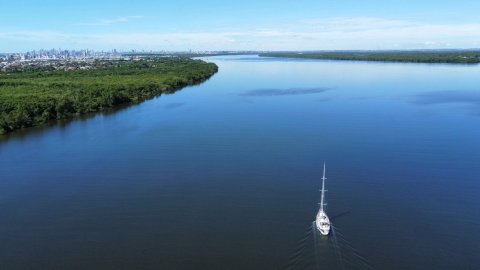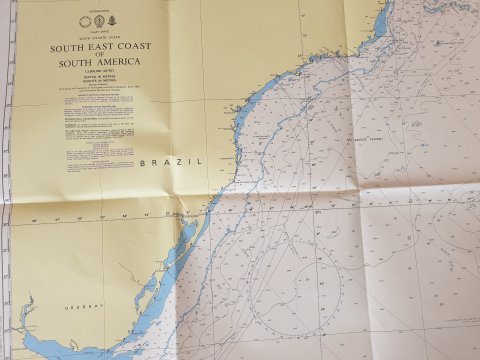Lanzarote, our Leg1 stop.
Normally when planning a stage departure from a port or anchorage we proceed very methodically.
1. The synoptic chart of the current day and the evolution for the following 3 days are studied, checking the position of the Low and High pressures and their movement on a large scale (100km resolution);

2. Two meteorological models are analyzed and compared. We compare the European ECMWF model with the European one modified by PredictWind called PWE.

3. We check that the boat is ready and in order, making clear all the manoeuvres, engine levels and status of the 24V service batteries and 12V engine starter and generator, fuel, water and galley.
At the end of all this, the stage is planned by calculating the distance to travel, the best route based on the trend of the direction and strength of the wind and checking what the routing programs recommend using 3 or 4 meteorological models. At which point you decide the time you will set sail and therefore the alarm clock.

Well in Arab countries this is NOT permissible or rather it is NOT possible to decide to leave the port at a time determined by the skipper.
The morning you decide to leave you must notify the Police and Customs. From that moment the wait begins which can last even some hours.
The wait ends when a staff of at least 2 customs officers and 2 or 3 policemen show up and start rummaging in all the lockers outside and inside, opening the floors, entering the engine room. All without respecting the sacred etiquette of those who come aboard on a sailing boat, that is, taking off your shoes before getting on... never!
This time, however, in Tangier I covered the deck and the interior with dozens of rags to clean the floors and it worked... everyone understood and at least cleaned their soles thoroughly on the first rags as soon as they got on board.
After the ritual questions about whether we have weapons and drones, everything finally ends and we can leave Tangier at 11h30 instead of 7h30 !
The north side of Morocco immediately appears to have little wind, especially along the coast, which forces us to start our Volvo Penta 145CV and move away from the coast for 10 hours of sailing.
At sunset the North West finally arrives that we were expecting but after a few hours with the darkness of the night arriving the wind force is well above the forecast with an average of 22 knots and gusts of up to 30 knots.
The dancing begins and will last about 48 hours!
Since We are only 2 of us, me and Olivier, we have to opt for 4 hour shifts, a little long in winter with low temperatures but necessary to be able to cover the night which is very long in winter...
So 1st shift after dinner from 20h00 to 24h00, the 2nd until 04h00, the 3rd until 08h00 when dawn returns and the 2nd skipper can opt to rest in the cockpit or go down to the cabin for the 4th shift of rest .
Night is the most delicate moment because maneuvering a jibe or a tack only with the benefit of a front light to illuminate the cockpit and adjusting the sails becomes a demanding operation. The other fundamental aspect is that whoever is on rest MUST rest, it is an obligation of whoever is on duty to think about the rest of the other. Sometimes, indeed often, this is not the case, because the sea conditions, the wind force and direction change and therefore you have to decide what to do and how to do it.
Another aspect that I immediately understood is that here in the ocean the direction of the wave must be carefully evaluated to allow the boat to suffer as little as possible as well as the crew, especially for those who have to rest. In the first 48 and always in the middle of the night the wind started to rotate towards the NE from around 35° which with our route means having it from 145 to 165°, therefore almost astern. While the sea continued to descend from the NNW with ever greater force and grandeur.
The result was that Pius struggled to maintain a good speed due to sailing too far downwind with a powerful and very fast wave (about 10 knots) which moved the stern up to 10 or 15 metres, thus taking pressure off the sails.
3 times in the first 60 hours and always at night it was necessary, not without difficulty, to jibe on port tack, bringing Pius more to the wind, therefore with the sails benefiting from more pressure and therefore speed on the water and with the wave of full stern which allows the boat to roll less, remaining flatter and faster thanks to the push of the waves themselves.
In the middle of the crossing a small bird landed on Pius, perhaps looking for a bit of rest considering that the first reachable land was over 200 km away!

After 82 hours and 580 miles, at 04h00 on February 21st we entered the Port of Arrecife on the island of Lanzarote, Canary Islands.
In the morning we hug the new arrival, Marco nicknamed the Perugino with the long tongue. ;) Young skipper willing to approach long ocean voyages.
The language on board becomes English to the detriment of French.
The desire to walk is strong after almost 4 days of navigation and not far from Pius I see the future... the largest sailboat ever built to sail on foils.


Having practically not slept for 2 days I thought I would wake up after 12 hours but at 10 we were already at the table to plan the necessary repair and maintenance work before leaving for the 2nd leg: Canary Islands/Mindelo in Cape Verde.
We thought we would stay for half a week but the maintenance and repair work took particularly long:
- replacement of the 3rd mainsheet block due to fracture of the original Lewmar block;
- Spinlock stopper cam replacement
 -
-
dismantling of the old support and foothaul block for installation of a new Iroko support with 2.5mm stainless steel plate base and 2.5mm stainless steel plates between the deck and self-locking nuts. This took us a whole day as we didn't have a workshop with appropriate tools to drill the steel plates and drill the deckhouse perpendicularly to the (inclined) floor.


Forced to shelter from gusts >35kts!



- checking sails and patches for small tears at the base of the mainsail;

- checking sheets and halyards and sewing protections and inserting a protection disc on each genoa sheets to avoid wear of the pole;

- check backstay and vang hydraulic oil levels and furling mainsail and genoa;
- rigging control up to the top of the mast;
- disassembly of hydrogenerator propeller for checking and greasing;

- checking steering and cardans and greasing oil seals;

- change oil and engine oil filter, change diesel pre-filter and primary filter and sea pump impeller;
- check propeller and anode status;
At last we discovered some cracks on the toggle of the backstay. Once removed from the backstay we verified that they were scratches and not through cracks.

The time needed to finish everything (6 days) was the duration of a strong storm surge from NE F8 !
Luckily we had great musical accompaniment!

Now Pius and We are ready for the Canary/Cape Verde crossing (Mindelo)!



0 Comments